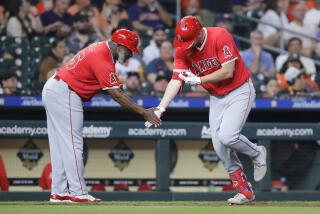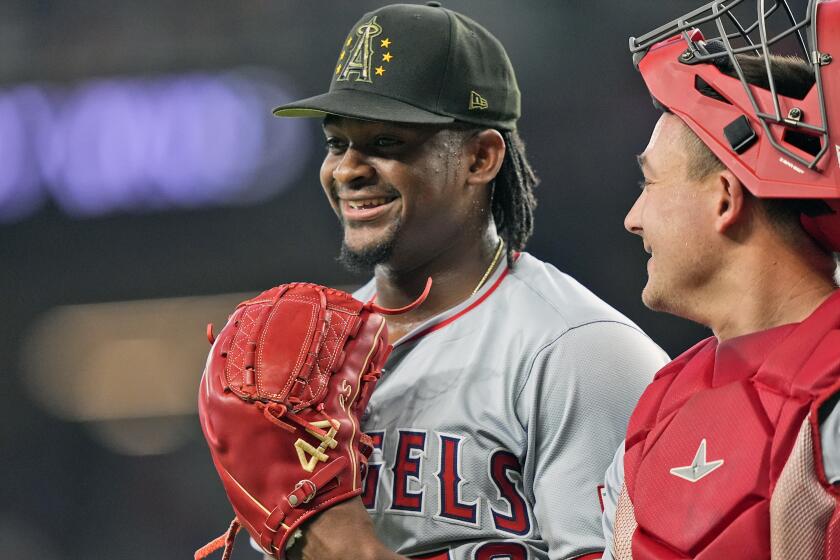Angel Fans, Giant Fans: The Drivers, the Driven
At one ballpark, about half the fans arrive on trains, subways and trolleys, on foot, bicycles and even by sea. At the other, nearly everyone arrives by car. As an alternative, some might use their spouse’s car.
San Francisco and Orange County couldn’t be more different. Stereotypes abound: Fog and sunshine. Liberals and conservatives. The City and The Suburbs.
As the World Series gets underway today, even the way fans of the Anaheim Angels and the San Francisco Giants take themselves out to the ballgame offers a metaphor for the stark differences that divide north from south in California.
Pacific Bell Park in San Francisco and Edison International Field in Anaheim are models of transportation efficiency that would be utter failures if their locations -- and philosophies -- were swapped, experts say.
“The Orange County lifestyle is very different from the San Francisco lifestyle,” said Mike McNally of UC Irvine’s Institute of Transportation Studies. “San Francisco built the ideal stadium for its region. At the same time, I don’t think you could build the Big Ed in a way that it would serve what we have here better.”
In a city that has long viewed freeways with disdain, as the concrete embodiment of civilization’s decline, Pacific Bell Park was designed to rely on public transportation. Driving has been so discouraged since the stadium opened in 2000 that its 5,000 parking spaces often don’t fill up.
By contrast, Orange County and all of Southern California have long viewed freeways as the lubricant that allows civilization to move forward. To that end, Anaheim Stadium (now Edison Field) opened in 1966 near the confluence of three freeways with the automobile in mind -- with only the automobile in mind.
There’s a Metrolink station a few line drives from left field, and fans could use it to get to games. Except Metrolink trains don’t run through Anaheim on weekends, and during the week the last train leaves at 7:10 p.m.
“San Francisco has always reminded me of an East Coast city in every way. They’re much more into public transit,” said George Urch, spokesman for the Orange County Transportation Authority, whose buses run past Edison Field but aren’t allowed inside the parking lot. “The car is king down here.”
A city of San Francisco Web site offering parking tips begins with this deadpan observation: “Parking in the City can be difficult.” That’s about as optimistic as the official line gets. A map of parking restrictions around Pac Bell Park would take both Rand and McNally to navigate.
“Our goal was to make getting to the ballpark [on public transportation] a big part of the whole ballpark experience,” said Alfonso Felder, transportation program manager for the Giants. “And it has. It has become part of the culture of the place.”
There are other advantages. “If you take BART, you can stop after the game, have a few belts and you don’t have to drive,” said Jim Hodges of the San Francisco Department of Parking and Traffic. “It works so much better.”
A study of how people get to Pac Bell Park found that about 45% come by public transportation, 5% on ferries that dock at the waterfront park and 2% by “creative means” -- mostly on bikes that have a parking lot reserved for them. Only 48% of fans come in a car.
No one studies how fans get to Edison Field, but it’s assumed that boats aren’t in the mix, since the nearby Santa Ana River is nearly always dry.
“There’s an idea out there that insists that public transportation is good and that cars are bad,” said McNally, the UCI transportation expert. “Not only is that too black and white, it’s just plain wrong.”
As a tourist destination that draws 20 million visitors a year, Anaheim is at the forefront of traffic planning in Southern California. Since 1988, personnel at the city’s Traffic Management Center have monitored sensors in roads and closed-circuit cameras to synchronize signals and keep cars moving in congested areas, including Edison Field on game days.
For most fans, it seems to work. John Lower, who manages Anaheim’s traffic network, said the city used to track how long it took all the lots at Edison Field to empty after games but stopped five years ago “because nobody complains.”
Bill Stafford certainly doesn’t. The 43-year-old Angels fan from Mission Viejo has never had a problem getting in and out of Edison Field. If public transportation works in San Francisco, that’s great, Stafford said. It just wouldn’t work here.
“Nothing is easier than this,” he said.
Freeways versus trains. Angels versus Giants. To Stafford, it’s all part of the greater rivalry.
“The feud between north and south is on all fronts. Everything they have is seen as better than the way we have it,” said Stafford, who grew up in Fullerton and went to college in San Jose for a year until the unrelenting criticism he received for all things Southern California forced him to come back closer to home.
“I think it goes back to the aqueduct. There’s always been some sort of aggravation on the part of Northern Californians who see all their water coming down here,” he said. “In Northern California, they view everything south of San Luis Obispo as being Los Angeles.
“This World Series is a clash of north and south like nothing else I’ve ever seen.”
More to Read
Go beyond the scoreboard
Get the latest on L.A.'s teams in the daily Sports Report newsletter.
You may occasionally receive promotional content from the Los Angeles Times.






